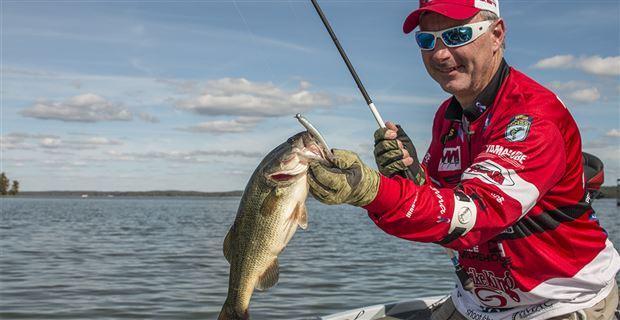Swimbaits are no longer exclusive to the California bass fishing scene. In recent years, we’ve seen an explosion of smaller versions of these minnow-shaped lures that, to no surprise, are catching giant bass throughout the entire country. You wouldn’t think a trophy-class bass would attack such a miniscule bait, but it happens a lot more than many anglers think. The productivity is simply undeniable.
According to Elite Series pro Mark Menendez, you need to know 5 things in order to maximize your success with these baits.
1. Consider body shape, flanges and durability
With little effort, you’ll find all different shapes and sizes when you’re shopping for small swimbaits. In general, however, the ones designed with a v-shaped body are often most productive and efficient.
“There’s no need to get too fancy with your swimbaits,” Menendez said. “A basic v-shape, like that of the Strike King KVD Swim-N-Shiner, seems to work best throughout the country. This design helps it track straight in the water without rolling on its side too much while keeping the hook point in line for solid hookups in the roof of the fish’s mouth.”
It’s also good practice to carefully inspect the flange around swimbait’s boot tail. One that’s too dull will result in less action and, consequently, fewer bites. Menendez looks for a sharp, crisp flange in every situation. It’s just like a boat propellor—the sharper the edge, the more efficiently it will cut through the water.
Durability is also an important consideration. Not only does it reduce wasted fishing time, but it also saves money.
“I’m very particular about the durability of my soft swimbaits,” Menendez said. “These baits catch everything and you’re bound to have panfish and white bass nipping at the tail. If your swimbait is too soft, you’ll go through a lot and it will become fairly expensive after a few trips.”
2. Both round and football-shaped jigheads have a purpose
There’s a certain degree of apprehension in regards to rigging swimbaits, but keeping it simple and rotating between two primary jighead styles can pay big dividends.
“Most of the time, I’m using a round, ball-shaped jighead such as the Strike King Tour Grade Shakey Head,” Menendez said. “This gives you an excellent hookup ratio and the gap between the hook point and the hook shank doesn’t kill the action of the swimbait.”
When targeting bass in the 20-foot depth zone, football-shaped jigheads are an outstanding choice. Although they’re often used for bottom-contact presentations, the head’s center of gravity keeps the swimbait in the optimal depth zone for an extended period of time.
3. 18 to 24 inches is critical
Boot-tailed swimbaits don’t emit much vibration throughout the retrieve. Because bass cannot easily sense them with their lateral lines, you’ll enjoy most of your success when utilizing these baits in clear water situations.
“These swimbaits are a very sight-oriented presentation,” Menendez said. “If the bass can’t see them, they probably won’t even know they’re in the vicinity. If you don’t have at least 18 to 24 inches of water clarity, you’re probably better off choosing another type of lure.”
That’s not to say, however, that they don’t play somewhat of a role in dingy water. Dark-colored 4-inch swimbaits are a very popular trailer choice for swim jigs, vibrating jigs and spinnerbaits when targeting bass in off-color water. Not only does this add a bit of bulk to your presentation, but it also allows you to retrieve these lures at a slower rate while keeping them higher in the water column.
4. Chuck and wind
With all of the complicated technicalities in bass fishing, it’s refreshing to use a simple and straightforward technique from time to time. In the case of finesse swimbaits, simplicity is a beautiful—and powerful—thing.
“These are quite possibly the easiest baits to fish,” Menendez said. “It’s all about chucking and winding, really. That’s exactly why it’s such a good technique for inexperienced anglers. It works equally well in ponds, creeks, streams and big reservoirs. I make a long cast with a 7-foot Lew’s Custom Speed Stick Spinning Rod and use a basic moderate retrieve with my 6.2:1 Lew’s Tournament Pro Spin Spinning Reel.”
Like any presentation, the bass will prefer different retrieve speeds depending upon their mood, so experimentation remains an important aspect. But just remember to keep it simple. The bites are an unmistakable and often-aggressive “thump”, so bite detection and solid hookups are particularly easy.
5. They can excel around thick vegetation
We’ve mentioned the use of round and football-shaped jigheads, but don’t discount the effectiveness of belly-weighted swimbait hooks when you’re faced with dense vegetation. This style of hook keeps the hook point buried in the swimbait, creating a very weedless option for fooling bass in the thick stuff.
“Whether you’re targeting grass or skipping under boat docks and willow trees, belly-weighted hooks are the way to go,” Menendez said. “To make tricky skip casts a bit easier, I prefer a 1/4-ounce weight with a 2/0 or 3/0 hook. If you go any bigger than that, you’ll kill the action of your swimbait and it won’t roll or flash properly. Conversely, if you use a smaller hook, you’re likely to miss a lot of quality bites throughout the day.”
This is also an outstanding way to catch bass from the shore. Instead of worrying about hang-ups and snags, you’re able to confidently target gnarly cover and present your swimbait to unmolested fish.
Not all swimbaits have to be big. The next time you’re faced with a tough bite, make sure you have a few packs of small swimbaits with you. They’re often a simple solution to a tough day on the water.














